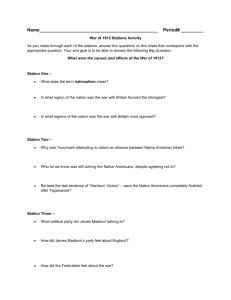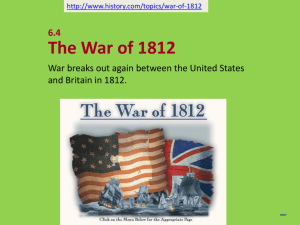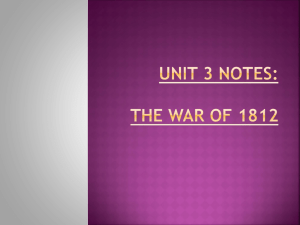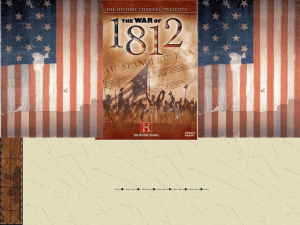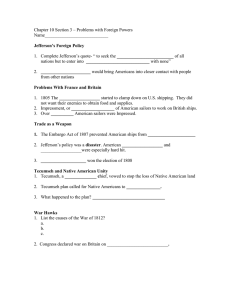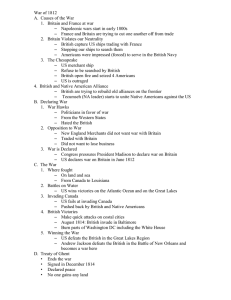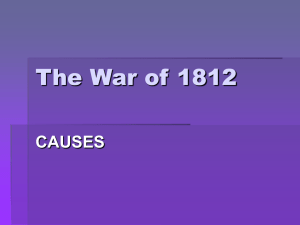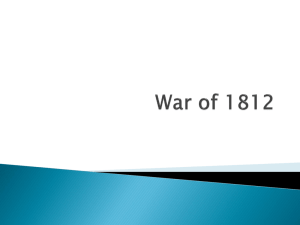WAR OF 1812 One Weird War: 1809-1815 And BACKGROUND:
advertisement
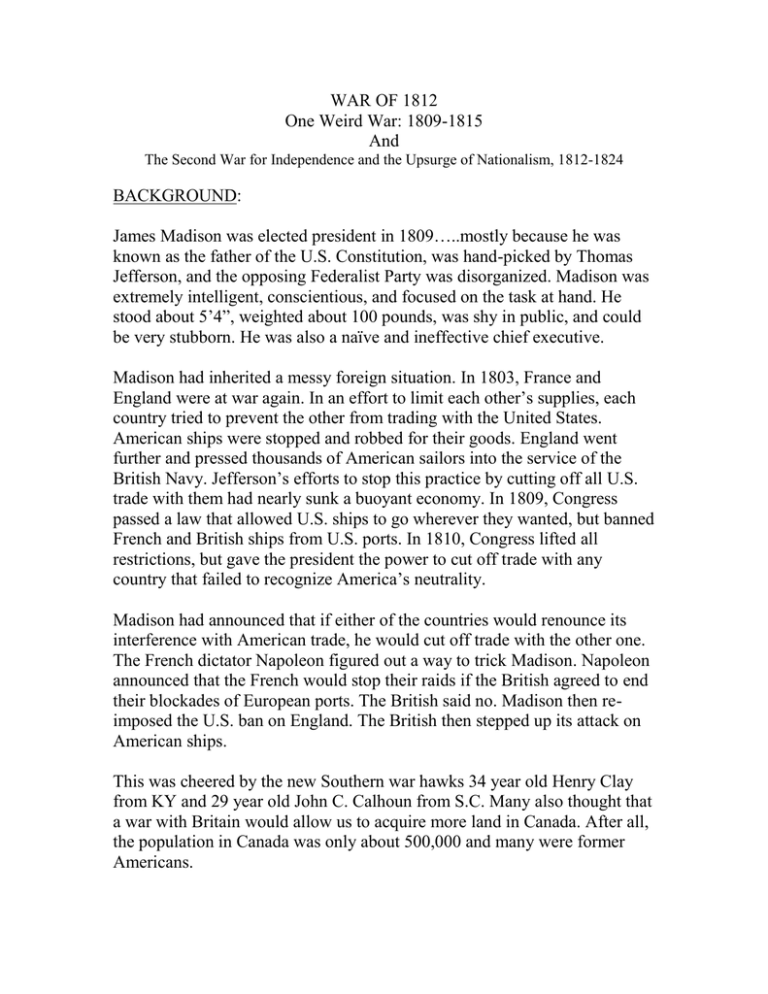
WAR OF 1812 One Weird War: 1809-1815 And The Second War for Independence and the Upsurge of Nationalism, 1812-1824 BACKGROUND: James Madison was elected president in 1809…..mostly because he was known as the father of the U.S. Constitution, was hand-picked by Thomas Jefferson, and the opposing Federalist Party was disorganized. Madison was extremely intelligent, conscientious, and focused on the task at hand. He stood about 5’4”, weighted about 100 pounds, was shy in public, and could be very stubborn. He was also a naïve and ineffective chief executive. Madison had inherited a messy foreign situation. In 1803, France and England were at war again. In an effort to limit each other’s supplies, each country tried to prevent the other from trading with the United States. American ships were stopped and robbed for their goods. England went further and pressed thousands of American sailors into the service of the British Navy. Jefferson’s efforts to stop this practice by cutting off all U.S. trade with them had nearly sunk a buoyant economy. In 1809, Congress passed a law that allowed U.S. ships to go wherever they wanted, but banned French and British ships from U.S. ports. In 1810, Congress lifted all restrictions, but gave the president the power to cut off trade with any country that failed to recognize America’s neutrality. Madison had announced that if either of the countries would renounce its interference with American trade, he would cut off trade with the other one. The French dictator Napoleon figured out a way to trick Madison. Napoleon announced that the French would stop their raids if the British agreed to end their blockades of European ports. The British said no. Madison then reimposed the U.S. ban on England. The British then stepped up its attack on American ships. This was cheered by the new Southern war hawks 34 year old Henry Clay from KY and 29 year old John C. Calhoun from S.C. Many also thought that a war with Britain would allow us to acquire more land in Canada. After all, the population in Canada was only about 500,000 and many were former Americans. Enter the Indians. By 1811, an inspirational Shawnee chief named Tecumseh had had enough of the land grabs by settlers in Ohio, Indiana, and Michigan. Aided by his famous brother Tenskwatawa, also known as ‘The Prophet’, they urged a holy war against the whites. They rallied tribe after tribe and urged them to give up everything white –their clothes, their tools, and especially alcohol. By late 1811, Tecumseh had put together a force of several thousand Indians. An army of about 1,000 U.S. soldiers, led by Wm Henry Harrison, marched to the edge of the territory claimed by Tecumseh, at Tippecanoe Creek, Indiana. ‘The Prophet’ led an attack against Harrison. It was a draw, but the Indian confederacy began to fall apart. The British then began to arm Tecumseh and his followers. In England, the long war with Napoleon and the trade fights with America had caused hard times. Britain was experiencing food shortages and an economic recession due to the lack of cotton for mills. So, on June 16, 1812, the British decided to stop raiding American ships. However, news traveled slowly, and two days later, Congress declared war on England under the rallying cry of “Free Trade and Sailor’s Rights.” –a small problem of communication. In doing so, the Jeffersonians were acting like Federalists in this expansionist and militaristic venture, and it called into question the classic Republican commitments to limited federal power and to peace. War was a bold –and foolhardy- move for a country with such a shabby military system. The U.S. had about 7,000 men and very few competent officers. One army official, Major General Henry Dearborn, was so fat he had to travel in a specially designed cart. The U.S. Navy consisted of 16 ships. A fair-sized segment of the population was against the war, particularly in New England. Many of them supported England. REASONS FOR WAR: British and French were attacking our ships and taking goods and sailors. We were neutral. Americans thought that the British were encouraging Indians to attack American settlements. Americans living in the Northwest Territory wanted to claim more land in Canada that belonged to Britain. War Hawks in Congress. THE WAR: A U.S. command of about 1,500 troops marched to Detroit, as a staging ground for an invasion of Canada. When a Canadian army showed up to contest the idea, the American General Hull, surrendered without a shot! After Hull’s defeat, another U.S. force tried to invade from Fort Niagara. This failed when many U.S. troops from N.Y. declined to fight outside of their own state. A third army set out from Plattsburg, N.Y., bound for Montreal, marched 20 miles to the border, only to quit and march back home. In September, 1813, a U.S. Navy flotilla built and commanded by Captain Oliver Hazard Perry destroyed a British fleet on Lake Erie. Perry’s victory was notable not only for the famous saying that came from it –“We have met the enemy and they are ours”- but because it forced the British out of Detroit and gave Harrison a chance to beat them at the battle of the Thames River. Tecumseh, the Indian leader who was now a brigadier general in the British Army, was killed and the Indian-Britain alliance squelched. The victories of Perry and Harrison kept the British from invading the U.S. through Canada, but the efforts to conquer Canada were over. Things were a little better at sea. With most of Britain’s navy tied up in Europe, U.S. warships, called frigates, like the Constitution, United States, and President won several one-on-one battles with British ships. The U.S.S. Constitution destroyed two British ships and became known as ‘Old Ironsides.” Congress decided to build more ships. However, when British ships were freed up in Europe, they bottled up most of the U.S. Navy in American ports from 1813 to 1814, and the American victories at sea ceased. By mid-1814, the English had finally defeated Napoleon and sent him into exile on the island of Elba. They turned their full military attention to the war in America –and unlike the first war with England, America wasn’t getting any help. In August 1814, a force of about 4,000 veteran British troops landed in the Chesapeake Bay area east of Washington, D.C. At the village of Bladensburg, the Brits encountered a hastily organized force of 6,000 American militiamen. Almost as soon as the shooting started, the militia ran and the British army strolled into America’s capital. The government officials fled, and the British burned every public building in the city including the Capitol and the president’s home –later painted white and renamed the White House. The burnings were partially to avenge the American torching of York (Toronto) and partially to take the heart out of the Yanks. Instead, it enflamed U.S. anger and delayed the British advance on Baltimore, which was the real military target. By the time the British forces got to Baltimore, the city’s Fort McHenry had been fortified; it was September 12, 1814. An all-night bombardment of the fort accomplished nothing, except to inspire a Washington lawyer who watched it from the deck of a British ship, where he was temporarily a prisoner. Francis Scott Key jotted down his impressions in the form of a poem, on the back of a letter. After the battle, he revised it a bit and showed it to his brother-in-law, who set it to the tune of an old English drinking song. It was published in a Baltimore newspaper as “Defense of Fort McHenry,’ but was later renamed “The Star-Spangled Banner.” Soon soldiers were singing it all over the country, but it was not adopted by Congress to be our national anthem until 1931. The British efforts to invade Baltimore ended. *Key’s son would be killed in the CW by Sickles. A second, even larger, British force attempted an invasion of the U.S. via a land-water route through New York. In September 1814, a British fleet sailed against an American fleet on Lake Champlain, near Pittsburg. The U.S. fleet, under the command of Lt. Thomas Macdonough, was anchored, and Macdonough rigged his ships so they could be turned around to use the guns on both sides. Thanks to this maneuver, the American fleet prevailed, and the British fleet retired to Canada. The third and last major British effort took place at New Orleans. A 20-ship English fleet and 10,000 soldiers squared off against an army of about 5,000 American soldiers, backwoods riflemen, and local pirates. The American force was under the command of a tall, gaunt Tennessee general named Andrew Jackson. Jackson had already made a name for himself as a great military leader by defeating the Creek Indians earlier in the war. They engaged in battle on January 8, 1815. It was a slaughter. The British charged directly at Jackson’s well-built fortifications, and U.S. cannon and rifles mowed them down. In less than an hour, the British suffered more than 2,000 men killed, wounded, or missing, compared to American losses of 71. The English retreated. Unfortunately, it came two weeks after the war had formally ended! Jackson became a national hero. Less than 15 years later, he was president. Ironically again, the slowness in communication was to be the cause of unnecessary bloodshed. AFTER THE WAR: Early in 1814, both sides agreed to a settlement. A few months later, America sent a team of negotiators to Ghent, Belgium, led by its minister to Russia, John Quincy Adams, and House Speaker Henry Clay. At first, the British negotiators dragged things out while waiting to see how their country’s offensive efforts worked out on the battlefield. England then demanded America turn over lots of land in the Northwest Territory and refused to stop kidnapping American soldiers from U.S. ships. But when news of the defeats of Plattsburg and Baltimore reached Ghent, the British changed their tune. They dropped their demands for territory, agreed to set up four commissions to settle boundary disputes, and agreed to stop the habit of “impressing” American seamen. On December 24, 1814, both sides signed a treaty that basically just declared the war over. “I hope,” said John Quincy Adams in toasting the treaty, “it will be the last treaty of peace between Great Britain and the United States.” It was! Though neither side could claim a victory, America did benefit from the increased manufacturing that developed to support the war. New England became America’s manufacturing center during the war, and after the war, the U.S. was less dependent on imports which led to a stronger national economy. The Oregon Territory in the Pacific Northwest was put under joint British and American control. In the end: Fewer than 6,000 U.S. soldiers and sailors were killed. No great changes came immediately from it; the land boundaries were returned to what they had been before the war. It was more like an armistice. America’s great system of lakes, bays, and rivers had become vital transportation arteries for both people and goods. New settlements and manufacturing centers sprang up along the country’s major waterways. The need to improve the transportation system combined with the growing confidence in the country’s industrial strength led to an ambitious construction project –the 363-mile long Erie Canal. The canal was officially opened in October 1825 with a procession all along the way from Buffalo to New York. This was part of Henry Clay’s “American System” which would include new roads into Ohio and beyond that would tie the country together economically and politically. *The National Road is still there. Madison thought that it was unconstitutional for the Federal Government to pay for them, so the state governments paid for them –including the Erie Canal. New England was also against the new road system; they feared it would drain away their population. They re-chartered the National Bank. Credit was established. Americans passed the first tariff to institute protection and not revenue. Britain was attempting to dump cheap goods on our market. The Federalists, opposed to the war and not aware that its end was coming, met in the Hartford Convention to consider a massive overhaul of the Constitution or, failing that, secession. When the war ended soon after, most people considered the Federalists to be traitors, and their national party dissolved –although the party continued to exert influence in some states through the next decade. For awhile, we had a one-part system. But the War of 1812 did serve to establish the U.S. firmly in the world’s eyes as a country not to be taken lightly. Other nations would develop a new respect for the U.S. It was this ‘Second Revolutionary War’ that finally severed ties with Great Britain. Knowing that they had held their own against powerful Great Britain, not once but twice, gave Americans respect and national pride. They turned their back on the Old World and looked west. VIP: The aftermath of the War of 1812 produced a strong surge of American nationalism that was reflected in economics, law, and foreign policy. The rising nationalistic spirit and sense of political unity was, however, threatened by the first severe sectional dispute over slavery. THINGS OF INTEREST: Sam Wilson, who owned a meatpacking business in NY, landed a contract to supply meat to the American Army. He had a habit of stamping U.S on the crates. Because the term “United States” was not often used, a meat inspector asked an employee of the Wilson Company what it meant –he joked and said “Uncle Sam.” By 1820, illustrations of “Uncle Sam” as a national symbol were appearing in newspapers. Wilson died in 1854, at the age of 88. His claim to be the original Uncle Sam was recognized by Congress in 1961. On March 16, 1810, the U.S. Supreme Court strikes down a state law as unconstitutional for the first time. On Nov. 20, 1811, construction begins on a federally financed road linking Cumberland, Maryland, to Wheeling, West Virginia. It would eventually stretch to Illinois and form the main route to the west. On Dec. 2, 1812, Madison wins a second term as president. In 1814, a Boston textile manufacturer named Francis Cabot Lowell established a factory that both spins and weaves cotton, using power machinery.
